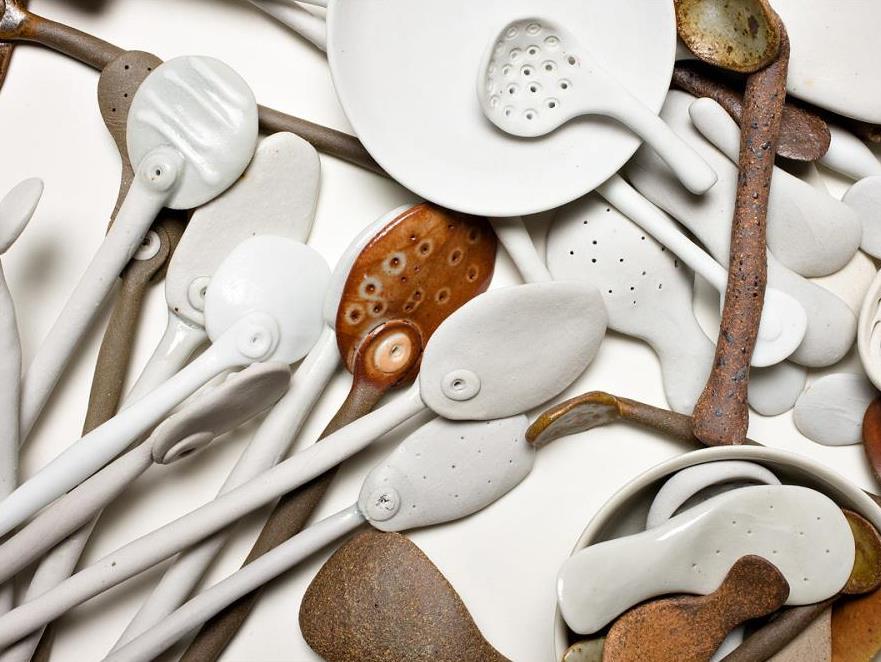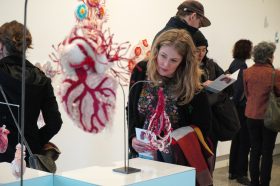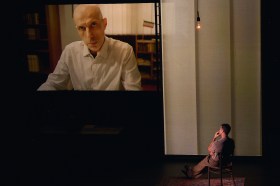Ceramics by Bridget Bodenham, Image via Craft Victoria
In Victoria approximately 80,000 people are engaged in some form of craft practice, but these numbers are not reflected in the allocation of public funding. The National Craft Initiative (NCI) state in Mapping the Australian Craft Sector (2014):
When comparing participation numbers with the level of funding received by various art forms, there appears to be significantly less funding allocated to the crafts compared with other art forms.
Craft Victoria decided to investigate this issue and provide current information on grants and public opportunity for makers by holding a seminar bringing together the Australia Council for the Arts, Creative Victoria, City of Melbourne and Asialink. In the process we busted a few myths about craftspeople accessing grants and opportunities for career development.
The Australia Council for the Arts say that while traditionally applications from craft have been low, there has been an increase since the simplification of their funding model introduced 18-months ago (along with an increase in success rates for both emerging artists and first time applicants.) Creative Victoria and City of Melbourne both said that there was still a lack of applications coming from the craft sector. In discussions it became clear that there are a number of reasons craftspeople may be self-selecting out of grant processes.
Myth #1: You need to be a professional full-time craftsperson
You do not need to be working full time as a maker to access a grant, grants support makers at all levels of their career. Where in the past funding bodies often asked applicants to position themselves in an artistic career hierarchy, Guy Betts from the Australia Council for the Arts spoke about how the old career definitions of ‘emerging’, ‘mid-career’ and ‘established’ artist are no more.
Many available grants focus on the development of artistic careers. Creative Victoria said that they focus on what an opportunity will do for the individual’s career and how it fits in to their career plan. Melina Scarcella, from the Australia Council added, “We want to know why this opportunity is right for you and why is now the right time.”
Myth #2: You must be a visual artist to apply in the visual arts category
Visual arts covers a broad spectrum of disciplines. When applying for a grant with City of Melbourne or Creative Victoria the category of ‘visual arts’ includes craft and design. Many makers may consider themselves ineligible for grants because there’s no specific craft category.
Myth #3: Every application must have public outcomes like an exhibition
Understanding where your work will end up is an important part of the planning process. Makers need to take the time to explore what ‘public outcome’ may mean for their specific practice. “It doesn’t mean you have to be undertaking large scale works seen by thousands of people” City of Melbourne’s Meg Simondson said, “It could mean an open studio or workshop.” The outcome of the work should reflect the type of artist who creates it and where they are within their career.
Myth #4: Everything needs to be confirmed before you apply
Grant applications are always assessed against the criteria of viability and planning. This is an area in which applicants can distinguish themselves from the pack. Assessment panels need to be able to see that a project can be achieved with the resources specified and in the defined timeframes.
While comprehensive project planning is important, this does not mean that all details need to be 100 per cent confirmed prior to hitting submit. While you need to show evidence of developing alternate sources of funding, for example, you do not need to have received approval.
Our speakers also offered a number of general tips to maximise chances of success:
Understand and communicate your point of difference: How is your project unique and interesting? Having a clearly communicated point of difference is an important way to demonstrate a worthy project.
Articulate your project and practice in clear language: An application is a reflection of your story as a maker. You want the assessment panel to understand who you are and exactly what you plan to achieve with the funds requested. This means ensuring your application makes sense to a reader other than you. Remember it is going to be assessed by peers but as Guy Betts said “If you can say it in twenty words, don’t say it in 100.”
Quality support materials: High quality images are crucial, but Christabel Harvey from Creative Victoria also stressed the need for image explanations, “Are they finished works? Work in progress? Ensure the assessment panel know what they are looking at.”
Address your funder’s specific needs, strategy and criteria: You must ensure your application meets the organisation’s key criteria. Meg Simondson says “Read our strategic plan, our arts strategy, we want to see you’re aligning with our goals. Feed our words back to us.”
Contact the funders to discuss your application: Christabel Harvey says “Call us twenty times”. The Australia Council team concurred, “Call us and chat with us at our monthly online forum.” Grants teams are there to ensure artists understand the application process.
Consider being on the assessment panel: Being a peer is valuable experience to contribute to your community, get a snapshot of what is happening in the sector and learn about what makes successful applications. While you obviously can’t apply for a grant at the same time as being on the panel, you don’t have to be an established artist to participate. All funders want diversity of background and experience in their peer panels. And yes, you do get paid.
The funding and public opportunity landscape has changed considerably in recent times. It’s important for those in the craft community to understand what opportunities are available and how to best maximise their chances for success. Craft Victoria is proud to have hosted such a valuable forum and extend our thanks to the Australia Council for the Arts, Creative Victoria, City of Melbourne and Asialink for generously sharing their expertise.





